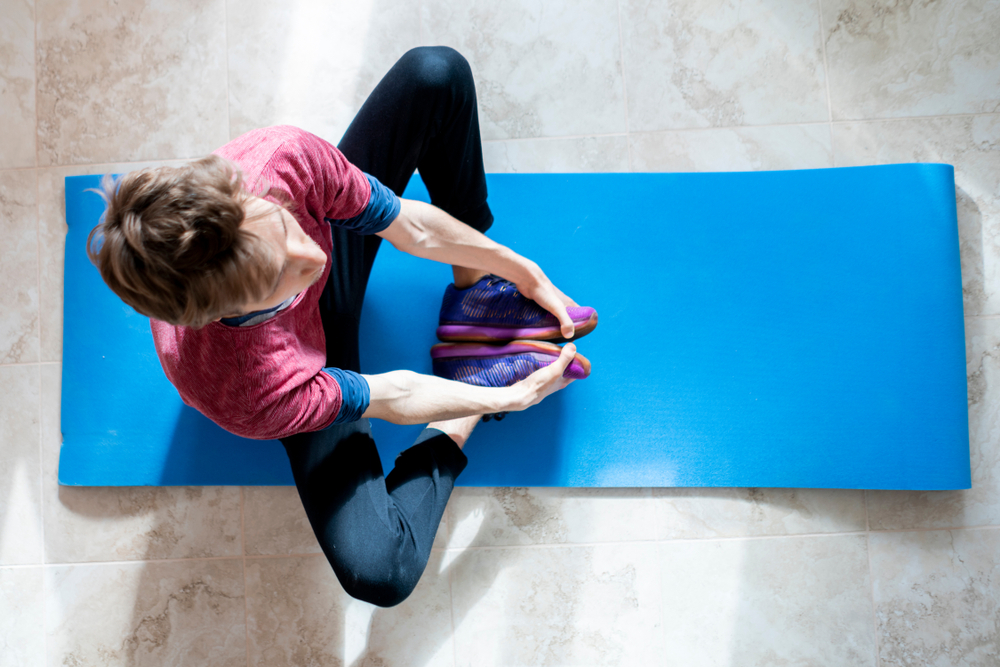Exercises And Stretches To Help Relieve Back Pain Associated With Ankylosing Spondylitis


Relieve Ankylosing Spondylitis With Posture Exercises
This form of strength training focuses on your core. When you improve your posture, you reduce the slouching that strains your back. Two strengthening exercises to promote good posture include: (1)
1. Standing Against A Wall
Stand with your back against a wall and follow these steps: (1)
- Keeping your back straight and your heels and buttocks against the wall, squeeze your shoulder blades together and hold that position for 5 seconds and release.
- Repeat several times.
2. Lying Prone
Lie on your stomach on the floor or a flat surface and follow these steps: (1)
- Turn your head to one side with your arms straightened towards your feet.
- Move your arms forward so you can slowly prop up your body on your elbows.
- Continue to lift trying to get your chest off the ground.
- Turn your head to face forward and hold the position for 10 to 20 seconds.
- Return to the starting position.
Relieve Ankylosing Spondylitis With Strength Exercises
Exercise keeps you active, but can be difficult if you are experiencing back pain. However, the following strengthening exercises are designed to help reduce pain: (1)
1. Superman
Named after the iconic Superman flying stance, you can follow these steps to help with AS back pain: (1)
- Lie on your stomach and stretch your arms forward with your legs extended behind (just like Superman flying).
- Lift your arms, chest, head, and legs off the floor holding the position for 5 to 10 seconds and then release.
- If you find lifting both legs painful or difficult, try lifting only one arm and the opposite leg, keeping the other arm at your side and the other leg on the floor.
- Repeat 5–10 times.
2. Plank
This infamous exercise can be challenging, but does a great job at stabilizing your core. You can alter how long you hold your position and gradually lengthen the time following these steps: (1)
- Lie on your stomach keeping your forearms flat on the floor like railroad tracks in front of you. Align your elbows below your shoulders (your elbows should be at or near a right angle to the floor).
- Press the forearms and elbows firmly down, and lift your hips so your forearms and feet are supporting your body (your body should be parallel to the floor).
- Hold the position for 10–20 seconds, or as long as you can.
Relieve Ankylosing Spondylitis Symptoms With Stretches
Stretching not only helps with mobility and strength, but can also feel wonderful. Use these stretches to help manage your AS: (1)
1. Quadricep Stretch
Your quadriceps are the large muscles at the front of your thighs. You’ll need to use an exercise band, towel, or a belt, to hold your foot in place. These stretches can help improve your hip mobility which is very important in managing back pain. Stretching the hip flexor muscles, ligaments and tendons helps mobilize the spine, increasing range of motion and helping ease back pain. Follow these steps: (1,2)
- Lie on your stomach and bend one knee, looping the exercise band, towel or belt around the top of that foot.
- Pull the strap back towards your shoulders to lift your foot until you can feel your thigh muscle stretch.
- Hold for several seconds.
- Repeat with your other leg.
2. Figure Four
This is another good stretch for hip mobility: (1)
- Sit in a chair with your feet flat on the floor and place your right foot on your left thigh just above your knee.
- Your right knee will naturally point out to the right, creating something of a figure 4 with your legs. Keep the spine tall and straight.
- Slowly bend forward and hold for 10–20 seconds.
- Release the position and then repeat for the other side.
3. Yoga
Yoga is an ancient system of self care which has been shown to have possible health benefits both mentally and physically. It can strengthen muscles and improve flexibility which in turn helps with back pain. Some poses you can use to help manage back pain include: (3,1)
Cat And Cow
- Get on all fours on a soft surface such as a yoga mat.
- Align your knees beneath your hips and your wrists beneath your shoulders.
- Inhale and lift your gaze and tailbone upwards toward the ceiling as you lower your stomach towards the floor, like a cow belly..
- Exhale bringing your head down and tuck your chin towards your chest.
- Tuck your navel towards your spine and arch your back like a cat.
- Slowly alternate between these positions several times, flexing and extending the spine.
Extended Child’s Pose
- Get on all fours and draw your hips back toward your heels. Allow your arms to be fully extended in front of you, palms on the floor.
- Hold this position and breathe slowly in and out for several breaths.
Although living with back pain caused by ankylosing spondylitis can be discouraging, you can remain active using these exercises and stretches to regain flexibility and improve mobility. Click here to learn more about living a healthier rhythm.
Sources:
- https://www.medicalnewstoday.com/articles/ankylosing-spondylitis-back-pain#strength-exercises
- https://www.ncbi.nlm.nih.gov/pmc/articles/PMC4934575/
- https://www.health.harvard.edu/staying-healthy/yoga-benefits-beyond-the-mat









